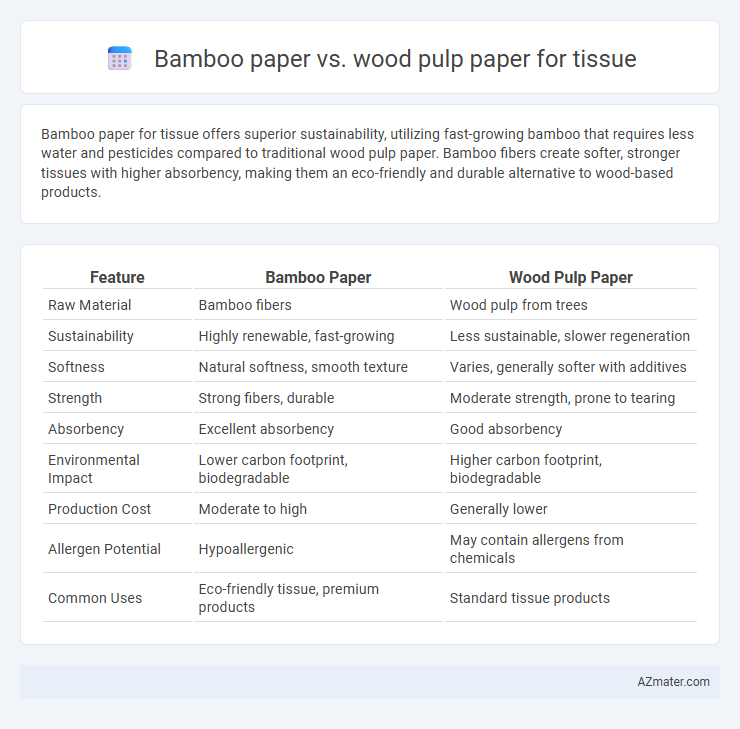Bamboo paper for tissue offers superior sustainability, utilizing fast-growing bamboo that requires less water and pesticides compared to traditional wood pulp paper. Bamboo fibers create softer, stronger tissues with higher absorbency, making them an eco-friendly and durable alternative to wood-based products.
Table of Comparison
| Feature | Bamboo Paper | Wood Pulp Paper |
|---|---|---|
| Raw Material | Bamboo fibers | Wood pulp from trees |
| Sustainability | Highly renewable, fast-growing | Less sustainable, slower regeneration |
| Softness | Natural softness, smooth texture | Varies, generally softer with additives |
| Strength | Strong fibers, durable | Moderate strength, prone to tearing |
| Absorbency | Excellent absorbency | Good absorbency |
| Environmental Impact | Lower carbon footprint, biodegradable | Higher carbon footprint, biodegradable |
| Production Cost | Moderate to high | Generally lower |
| Allergen Potential | Hypoallergenic | May contain allergens from chemicals |
| Common Uses | Eco-friendly tissue, premium products | Standard tissue products |
Introduction: Comparing Bamboo and Wood Pulp Tissue Paper
Bamboo tissue paper offers superior sustainability due to its rapid growth rate and lower environmental impact compared to traditional wood pulp paper derived from hardwood trees. It typically contains more natural fibers, resulting in enhanced softness, strength, and absorbency for consumer tissue products. Wood pulp tissue paper remains widely used but has higher deforestation and chemical processing concerns impacting overall eco-friendliness.
Environmental Impact: Bamboo vs Wood Pulp
Bamboo paper for tissue production significantly reduces environmental impact due to bamboo's rapid growth rate, requiring less water and pesticides compared to traditional wood pulp sourced from hardwood forests. Bamboo's ability to regenerate without replanting minimizes deforestation and soil erosion, contributing to greater ecosystem preservation. Wood pulp paper production often involves extensive logging and chemical processing, leading to higher carbon emissions and habitat destruction.
Renewable Resource Analysis
Bamboo paper for tissue products offers a highly renewable resource advantage due to bamboo's rapid growth cycle, maturing in 3-5 years compared to wood pulp trees that take decades. Bamboo cultivation requires fewer pesticides and less water, significantly reducing environmental impact during production. Its high cellulose content increases fiber strength, allowing for softer and more durable tissues while promoting sustainable forestry practices.
Manufacturing Processes Compared
Bamboo paper production utilizes a rapid-growth grass that requires less water and fewer chemicals during pulping compared to traditional wood pulp paper, resulting in a more environmentally friendly manufacturing process. The mechanical and chemical treatments for bamboo fibers are optimized to preserve fiber strength and softness, while wood pulp paper typically involves longer processing times with harsher bleaching agents. Bamboo's higher cellulose content and natural antibacterial properties reduce the need for additives, enhancing the tissue's durability and hygiene without compromising sustainability.
Softness and Texture Differences
Bamboo paper for tissue offers a naturally softer and smoother texture compared to wood pulp paper, thanks to bamboo fibers' fine and long structure which enhances pliability. Wood pulp paper, while durable, tends to be rougher and less absorbent due to its shorter and coarser fibers, which can result in a less gentle feel on the skin. Bamboo tissue's hypoallergenic and moisture-wicking properties contribute to its superior softness, making it a preferred choice for sensitive skin.
Strength and Durability
Bamboo paper exhibits superior strength and durability compared to wood pulp paper due to its longer and denser fiber structure, enhancing tear resistance and lifespan in tissue products. Bamboo fibers contain higher cellulose content, contributing to enhanced tensile strength and softness, which improves both durability and user comfort. Wood pulp paper, while commonly used, tends to break down faster under moisture and stress, making bamboo paper a more robust and eco-friendly alternative for tissue applications.
Biodegradability and Compostability
Bamboo paper tissue demonstrates superior biodegradability compared to traditional wood pulp paper due to its natural fiber structure and faster decomposition rate, often breaking down completely within 45 days in composting environments. Bamboo's rapid renewability and minimal chemical processing enhance its compostability, allowing it to integrate seamlessly into organic waste systems without leaving harmful residues. Wood pulp paper tissues, while biodegradable, typically contain additives and longer fiber chains that slow composting and may contribute to microplastic pollution if not properly processed.
Cost and Market Availability
Bamboo paper for tissue production often incurs higher initial costs due to specialized processing, but offers competitive long-term savings through faster growth cycles and sustainable sourcing compared to traditional wood pulp. While wood pulp paper dominates the global market with widespread availability and established supply chains, bamboo paper is gaining traction in regions with abundant bamboo resources, driven by increasing consumer demand for eco-friendly alternatives. Cost-efficiency and market penetration vary significantly based on geographic location, raw material accessibility, and technological advancements in bamboo fiber processing.
Consumer Preferences and Trends
Bamboo paper for tissue products is gaining popularity due to its sustainable sourcing and natural softness, appealing to eco-conscious consumers seeking biodegradable alternatives. Wood pulp paper remains widely used for its affordability and traditional texture, maintaining strong market presence despite growing environmental concerns. Consumer trends indicate a rising preference for bamboo-based tissues driven by increased awareness of deforestation and a demand for premium, chemical-free products.
Conclusion: Choosing the Best Tissue Paper Option
Bamboo paper offers superior sustainability benefits due to its rapid growth rate and lower environmental impact compared to traditional wood pulp paper. Wood pulp tissue provides a familiar texture but often involves higher deforestation and chemical processing. Opting for bamboo tissue supports eco-friendly practices while maintaining quality, making it the best choice for environmentally conscious consumers.

Infographic: Bamboo paper vs Wood pulp paper for Tissue
 azmater.com
azmater.com